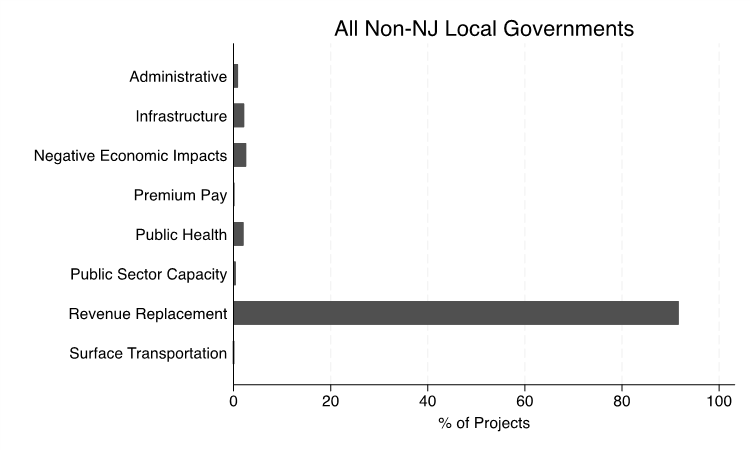By Pengju Zhang, Ph.D. and Michael S. Hayes, Ph.D.
The American Rescue Plan Act’s Coronavirus State and Local Fiscal Recovery Funds (ARPA-SLFRF) provides $350 billion to state and local governments, representing one of the largest federal aid programs to local governments in American history. Compared with previous intergovernmental aid from the federal government in history, the ARPA-SLFRF is characterized by its generosity and flexibility. Local governments can use these funds to replace lost revenue, invest in infrastructure, or enhance multiple social welfare programs.
As the December 2024 deadline for obligating SLFRF dollars is approaching, policymakers and the public are keen to understand how this aid has been utilized in practice and its potential equity implications among local governments. Building on our introductory policy blog, this policy blog analyzes the latest batch of Treasury data on ARPA-SLFRF, detailing how the funds have been allocated and used in New Jersey in comparison to other states.
The figures below break down local governments’ ARPA projects across several broad expenditure categories: 1) administrative projects support the management and oversight of ARPA fund administration; 2) infrastructure investments focus on water, sewer, and broadband capital projects; 3) negative economic impact projects provide financial assistance to households, small businesses, and nonprofits, including rent, mortgage, and utility assistance; 4) premium pay projects compensate essential workers for their efforts during the COVID-19 public health emergency, such as overtime pay for healthcare professionals; 5) public health projects specifically address healthcare-related needs; and 6) revenue replacement projects give local governments broad discretion to use funds for essential public services.
Figure 1 displays the percentage of ARPA projects for New Jersey local governments by expenditure category. Almost 90% of all ARPA projects across New Jersey local governments were reported as revenue replacement projects. The remaining ARPA projects across New Jersey local governments were public health (4%), negative economic impact (2%), administrative (2%), infrastructure (1%), and public sector capacity (1%). Figure 2 shows percentage of ARPA projects for all other local governments in the United States by expenditure category. Almost 92% of all ARPA projects across non-New Jersey local governments were reported as revenue replacement projects.
Overall, the figures suggest that local governments across New Jersey (and the United States generally) obligated most of the ARPA funding for revenue replacement projects. This pattern is consistent with existing findings based on larges cities and counties with populations over 250,000 (Haskins et al. 2023).
The SLFRF revenue loss provision, as outlined in the Treasury Department’s final guidance issued in April 2022 (Department of The Treasury 2022), offers local governments considerable discretion in project planning. This provision also exempts “revenue replacement” funds from many of ARPA’s reporting requirements and use restrictions, providing both flexibility and reduced administrative burden. These advantages largely account for why revenue replacement became the most popular category of ARPA-SLFRF funds among local governments.
Figure 1. The Allocation of ARPA-SLFRF Funds in New Jersey

Figure 2. The Allocation of ARPA-SLFRF Funds in All Other States

Pengju Zhang is an associate professor at Rutgers-Newark and Michael S. Hayes is an associate professor at Rutgers-Camden.
References:
- S. Department of The Treasury. 2022. Coronavirus State & Local Fiscal Recovery Funds: 2022 Overview of the Final Rule. Available at https://home.treasury.gov/policy-issues/coronavirus/assistance-for-state-local-and-tribal-governments/state-and-local-fiscal-recovery-funds/reporting-and-compliance.
- Haskins, Glencora, Joseph Parilla, and Julia Bauer. 2023. As Local Governments Finalize Their American Rescue Plan Priorities, Some Dollars Have Become Easier to Spend. Brookings Commentary. Available at https://www.brookings.edu/articles/as-local-governments-finalize-their-american-rescue-plan-priorities-some-dollars-have-become-easier-to-spend/

